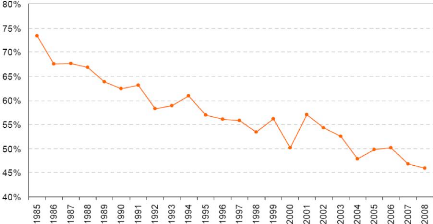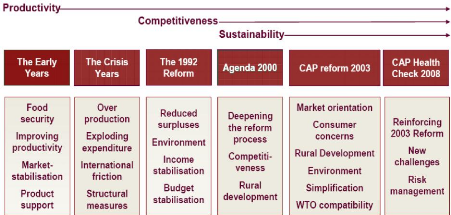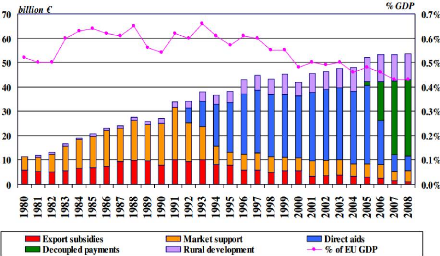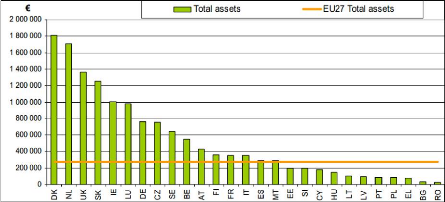1.2 The Profitability Heavily Relies on Subsidies, Not
on Investment Decision
To understand the farming business in France, it is necessary
to know the Common Agricultural Policy (CAP) and its impacts on Agriculture.
The CAP is the first and most important common policy for the European Union,
and its cost jeopardized the overall EU budget for years (Figure 4). The CAP
finds its origins in the 1950's, when European agriculture was on its knee
after World War II. Charles De Gaulle considered this policy as essential to
prevent major social events in France (Moravcsik, 1999), as he said that
agriculture was as important as the troubles in Algeria. This Policy helped to
increase the productivity, stabilized the agricultural markets, and secured
food supplies of all European countries (Clipici, 2011; Zaharia, Tudorescu,
& Zaharia, 2009; Howarth, 2000). According to Howarth (2000), its main
objectives given at its start in 1962 were:
- Agricultural productivity improvements
- Fair incomes for farmers
- Agricultural markets stability
- Secure food supplies
- Reasonable prices for customers

Figure 4: The percentage of the EU budget allocated to
the CAP Source: Eurostat, in Clipici 2011
However, the European CAP had been heavily criticized over its
history, either by European partners such as the Cairns group (Australia,
Brazil...) and the USA (Spencer, 2003), or by European countries also such as
the United Kingdom or Germany (Howarth, 2000; Elekes & Halmai, 2009;
Moravcsik, 1999). The major points of friction are the market distortions
induced by the CAP, the cost of this policy and the impact on the poorest
economies (Howarth, 2000; Spencer, 2003; Borrel & Hubbard, 2000; Rickard,
2001). Some authors even argued that world agricultural prices could rise by
38% if subsidies were turned off (Borrel & Hubbard, 2000). Many
negotiations rounds took place over the last decades to reduce these
distortions, and the CAP was reformed many times since 1992 (see Figure 5).

Figure 5: Historical Development of the CAP Source:
Clipici E., 2011
In 1992, the CAP was reformed to decrease export subsidies and
market supports to shift to coupled
direct payments. Those payments (direct
aids in Figure 6) were proportional to the surface cultivated
by farmers, but not directly to the volume of production. This
reform helped to reduce the production surpluses, and world agricultural
markets distortions were reduced. However, the distortions were still
significant after the reform as the overall amount of subsidies was really
high, around € 35 billion in 1992 (Clipici, 2011). All the other reforms
had the objective to reduce these distortions, such as the decoupled payments.
New conditions for granting were also added to the CAP such as environmental
protection, risk management, animal welfare, budget reduction, etc...

Figure 6: CAP spending evolution Source: DG
Agri
According to the Farm Accountancy Data Network (FADN), the
amount of subsidies represents 80% of the average recurring net profit for
French farms (see Table 1). Besides, grain producers depend even more on the
CAP than other types of farms.
|
2006
|
2007
|
2008
|
2009
|
2010
|
|
Subsidies
Recurring net profit before tax
Dependence on
subsidies
|
30
37
81%
|
29
46
63%
|
29
36
81%
|
29
21
138%
|
31
45
69%
|
Table 1: Subsidies and recurring net profit before tax in
France per farm, in K€ Source: FADN (RICA)
This dependence on subsidies is negative for innovation, as
all the production is oriented by the CAP and not by the market demand.
Moreover, the profitability depends on the capacity of the farmer to maximize
the subsidies. New-Zealand is an example of a country that stopped all
subsidies in 1984 (Gardner, 1994; Saunders, Wreford, & Cagatay, 2006;
Sandrey & Scobie, 1994), and enjoys nowadays an enviable situation in the
world agricultural market. This small country is the world largest milk
exporter (Evans, 2008), and the second largest sheep producer (FAO, 2012).
Another element limits the innovative capacity of French
farms, and also their adaptability: the control of the surface. As a matter of
fact the SAFERs, Societé d'Aménagement Foncier et
d'Etablissement Rural, have the power to control the land market.
According to their mission, these structures have 3 main objectives:
- Protect and revitalize agriculture: this objective means to
help young farmers to start their
activity, avoid the concentration on big farms, and develop a
peri-urban agriculture and organic farming. The major tool used here is the
preemption, which allows the SAFER to break a sale between to farmer to sell
the land to another farmer. Small and young farmers have the priority in this
system.
- Develop the vitality of the town and country planning policy:
the SAFER has the ability to
preempt some properties to help young entrepreneurs to start
their activity.
- Protect the environment: this last objective is really wide,
and goes from rehabilitation of
swamps to biodiversity protection and restructuration of the
forests...
The result of this policy is easily presented in Figure 7.
More liberal countries such as Denmark, the Netherlands or the United Kingdom
have much bigger farms, with an average capital assets per farm respectively of
1 820 000 €, 1 700 000 € and 1 370 000 €. On the contrary,
French farms have an average capital asset per farm below 400 000 €.

Figure 7: Average asset value per farm by member state
2007 Source: FADN
Some investments cannot be amortized in such small structures,
like methanation units for milk farms or precision farming for field crops. For
a methanation unit, which allows to reduce the impact on the environment by
producing electricity, the total investment is around 1 200 000 € for 250
kWe (AREC, 2011). This type of unit is not very important in terms of
productivity and can be 10 to 20 times bigger, but is already out of reach for
a small farm.
| 


